Egyptian statuette of Neith, Late Dynastic Period, 26th-31st Dynasty, c.664-332 BC
Bronze
Height: 24.8cm
11635
Charles Ede, London
Further images
-
(View a larger image of thumbnail 1)

-
(View a larger image of thumbnail 2)

-
(View a larger image of thumbnail 3)
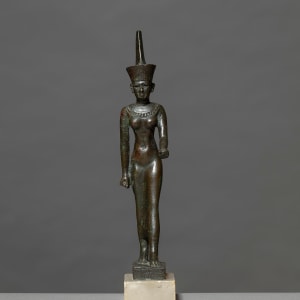
-
(View a larger image of thumbnail 4)
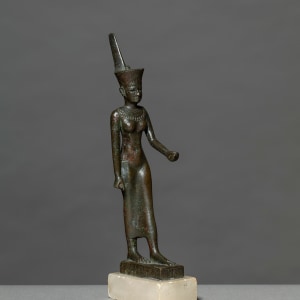
-
(View a larger image of thumbnail 5)
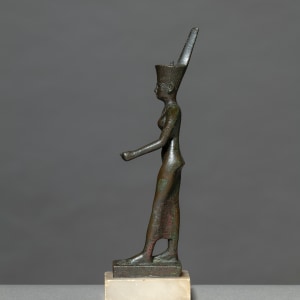
-
(View a larger image of thumbnail 6)
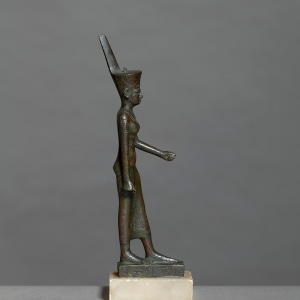
-
(View a larger image of thumbnail 7)
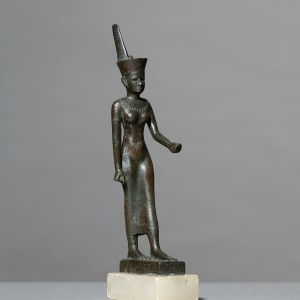
-
(View a larger image of thumbnail 8)
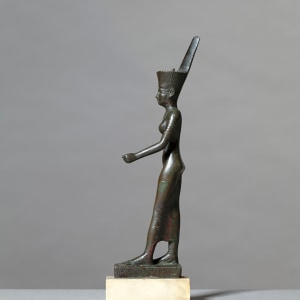
-
(View a larger image of thumbnail 9)
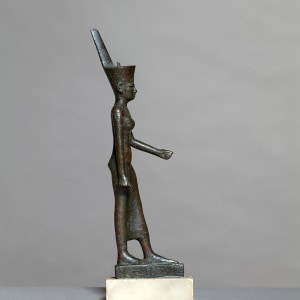
-
(View a larger image of thumbnail 10)
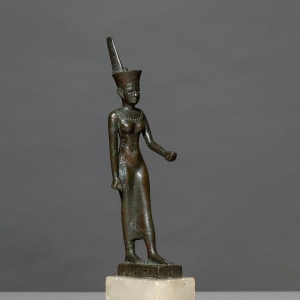
-
(View a larger image of thumbnail 11)
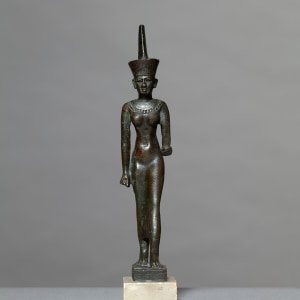
The goddess Neith stands on an integral base, her left foot slightly advanced and her left arm held up, gracefully bent at the elbow. Her hand is clenched to hold...
The goddess Neith stands on an integral base, her left foot slightly advanced and her left arm held up, gracefully bent at the elbow. Her hand is clenched to hold a separately cast, and now lost, was sceptre (the symbol of power), while her right arm rests by her side, once clasping an ankh, the emblem of life. The goddess is adorned with a close-fitting, finely woven garment which extends down to her ankles, and the Deshret, the iconic Red Crown of Upper Egypt. Intricately etched onto her chest is a broad collar, accentuating her divine status and regal presence, and around the base is a continuous line of hieroglyphs.
Left forearm restored, ankh, ‘was’ sceptre and the crown's curlicue now missing, though the top of the ankh remains. The dark brown patina has patches of red and green.
Neith was a highly significant deity in Egyptian mythology, associated with warfare and hunting, whilst being a protective maternal figure. The evolution of Neith's cult, from early invocation to a surge in prominence during the 26th Dynasty, underscores the dynamic nature of Egyptian religious beliefs over time. The shift towards portraying Neith as a genderless mother-father figure during this later phase of worship highlights the complexity and fluidity of ancient Egyptian theology.
Left forearm restored, ankh, ‘was’ sceptre and the crown's curlicue now missing, though the top of the ankh remains. The dark brown patina has patches of red and green.
Neith was a highly significant deity in Egyptian mythology, associated with warfare and hunting, whilst being a protective maternal figure. The evolution of Neith's cult, from early invocation to a surge in prominence during the 26th Dynasty, underscores the dynamic nature of Egyptian religious beliefs over time. The shift towards portraying Neith as a genderless mother-father figure during this later phase of worship highlights the complexity and fluidity of ancient Egyptian theology.
Provenance
Mr and Mrs Jarett, Alnwick, UK; acquired c.1930s-40s, on a white alabaster base typical of this period, formerly with Neith inscribed in black letteringElizabeth Williams, Burwash, UK; by descent from the above, her parents
William J. Williams (d.1994); inherited from the above, his wife
Private collection, Guildford, UK; gifted by the above 1993, his father










